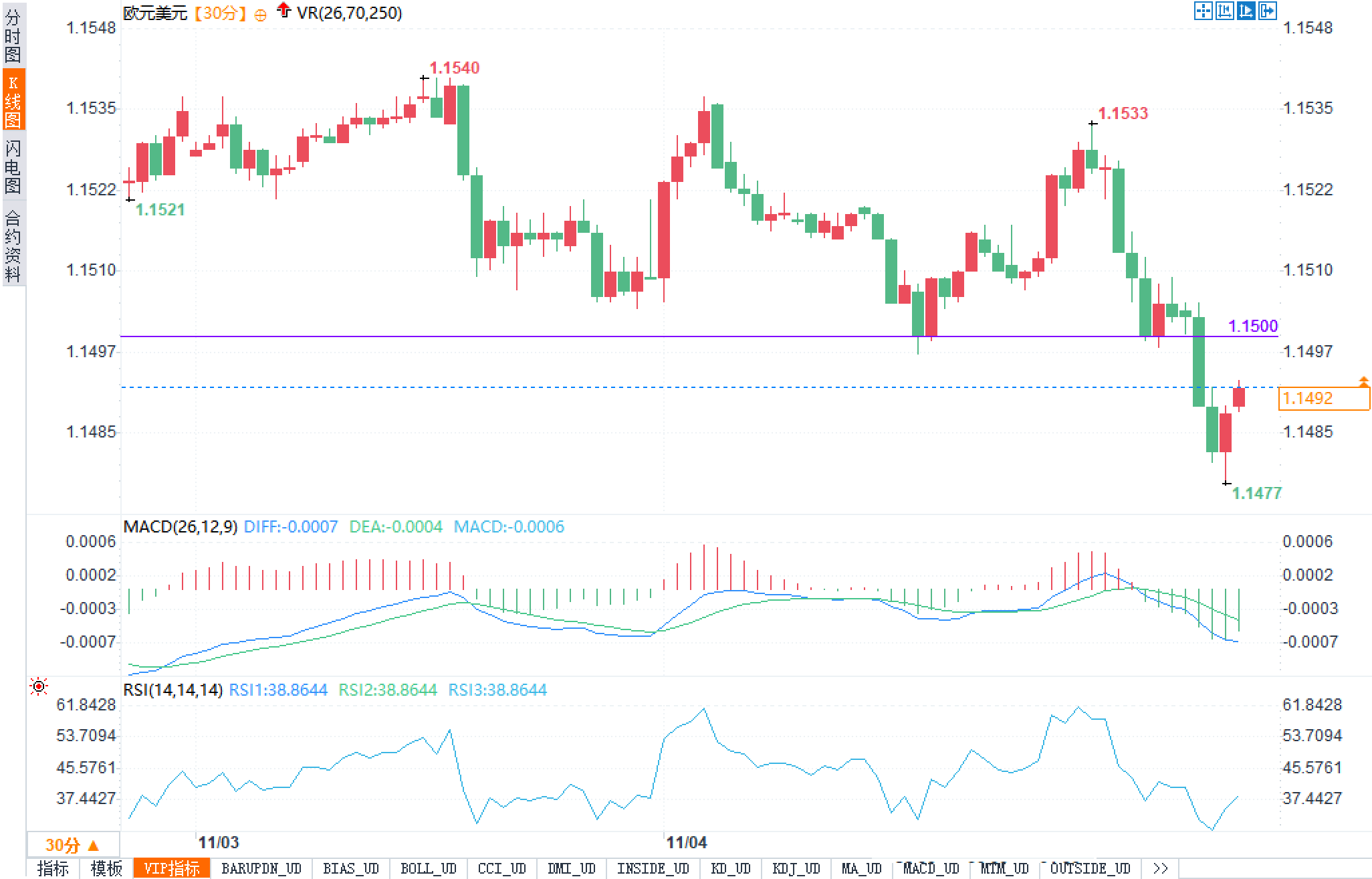On the eve of Wednesday's ADP report: Is 1.1477 the bottom or just a paper dot? A jobs report could send the euro hitting new lows.
2025-11-04 21:34:40

Fundamental Analysis: The US dollar remains resilient, while the euro's momentum is limited.
The US dollar remained strong this week, even though the US October ISM Manufacturing PMI fell to 48.7 (previous value 49.1, expected 49.5), marking the eighth consecutive month of contraction in the manufacturing sector. While the new orders index rebounded to 49.4 (previous value 48.9) and the employment sub-index rose to 46.0 (previous value 45.3), both remained below the 50-point threshold separating expansion from contraction. The data presented a complex signal of "weak growth and soft but not deteriorating employment": on the one hand, the drag from manufacturing has not improved enough to change the policy path; on the other hand, the risk of recession has not increased significantly, and the safe-haven appeal and interest rate differential support for the US dollar have not been fundamentally weakened.
Federal Reserve officials have expressed differing opinions. San Francisco Fed President Daly emphasized that inflationary pressures remain and that "moderate restraint" is necessary; Chicago Fed President Goolsbee similarly focused on inflation rather than the slowdown in the labor market. In contrast, Fed Governor Stephen Miran believes current interest rates are too tight. Pricing in interest rate swaps and federal funds futures has also seen slight adjustments: market bets on another rate cut in December have fallen from over 90% a week ago to about 67%, providing support for Treasury yields and the dollar index near their highs. In other words, the cooling of expectations for "faster and deeper rate cuts" has directly reduced the potential for a euro rebound in interest rates.
In Europe, the final reading of the Eurozone HCOB Manufacturing PMI confirmed a rebound to 50.0 (previous reading 49.8), technically returning to the expansion/contraction threshold, but resembling more of a "stagnation than expansion" scenario. Structural drags persist, and improvements in orders and output lack sustainability. Regarding the European Central Bank, after previously holding interest rates steady, the probability of it releasing new policy clues in the short term is low. In contrast, the market consensus of the Federal Reserve "continuing to observe rather than rapidly easing" is more likely to provide substantial support for the US dollar. Therefore, fundamentally, the exchange rate will continue to face dual pressure from interest rate differentials and risk appetite in the short term.
Meanwhile, the dollar index saw a modest pullback from its highs, but its downward attempts were limited. Risk aversion has not subsided, and the withdrawal of bets on further rate cuts in December offset the negative impact of weak manufacturing data on the dollar. Combined with the statistical gap caused by the US government shutdown, the lack of JOLTS job vacancies and factory orders has shifted market attention to Wednesday's ADP employment report. If employment remains resilient, it will further solidify the path of "slow rate cuts and prolonged pauses," continuing to be unfavorable for the euro.
Technical aspects:
Observing the 30-minute candlestick chart, the rebound of the exchange rate near 1.1530 was quickly rejected, and it subsequently broke below 1.1500, forming a clear downward breakout. The price touched a low of 1.1477 before rebounding. Currently, the price has returned to 1.1492, still below the "resistance-turned-support" level below 1.1500, indicating that the bears still have control over the short-term rhythm.

The MACD shows DIFF around -0.0007, DEA around -0.0004, and histogram around -0.0006. Overall, it is still below the zero axis, and the momentum is negative. However, the length of the histogram is shorter than before, indicating that the downward momentum is weakening and there is a need for a technical rebound. RSI (14) is around 38.86, which is below 50 but has not reached extreme oversold levels. Combined with the rapid recovery of the price to 1.1477, it constitutes a "short-term correction in a weak market". Overall judgment: 1.1500 constitutes the primary resistance. Above, pay attention to the overlapping supply areas of 1.1530/1.1533 and 1.1540. The immediate support below is 1.1477. If it breaks down again, the bears will try to extend to a lower liquidity-intensive area. Only if it stands back and stabilizes above 1.1500 can it open a retracement window to the 1.1530-1.1540 range.
Market sentiment observation:
Sentiment is cautious and risk-averse. High volatility in equity markets and the lack of substantial convergence in risk premiums for risky assets have given the US dollar a strong foundation, supported by both safe-haven demand and interest rate differentials. The market remains skeptical about a potential euro rebound. Disagreements surrounding the Federal Reserve's stance have temporarily increased volatility, but the consensus remains that policy will not quickly shift from "restrictive" to "accommodative" until core inflation convincingly declines. This means that a trading framework of "cautious on rallies, heavy selling pressure on rebounds" continues to dominate the intraday and extended trading of the euro/dollar exchange rate.
ADP employment data is the first catalyst this week that could change the pace of the market; if employment resilience exceeds expectations, bearish market sentiment may regain momentum; if it weakens significantly, profit-taking and position covering in the US dollar could trigger a technical rebound in the euro. The asymmetry in sentiment lies in the fact that the continuation of the bearish trend requires data confirmation, while the bullish momentum also needs to regain the key level (1.1500) to build consensus.
- Risk Warning and Disclaimer
- The market involves risk, and trading may not be suitable for all investors. This article is for reference only and does not constitute personal investment advice, nor does it take into account certain users’ specific investment objectives, financial situation, or other needs. Any investment decisions made based on this information are at your own risk.





















